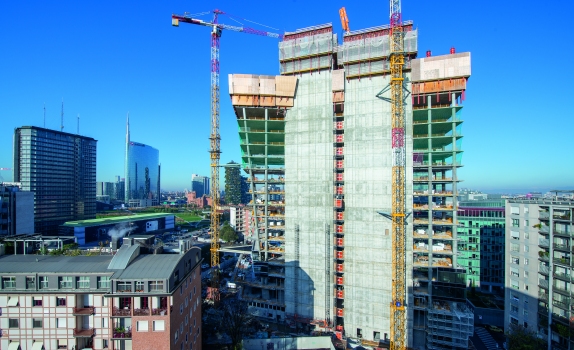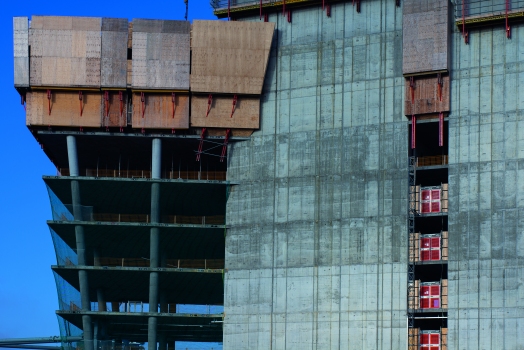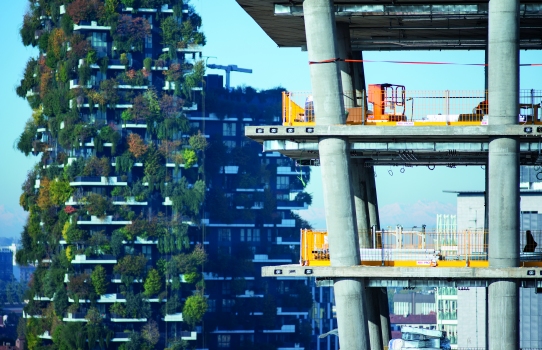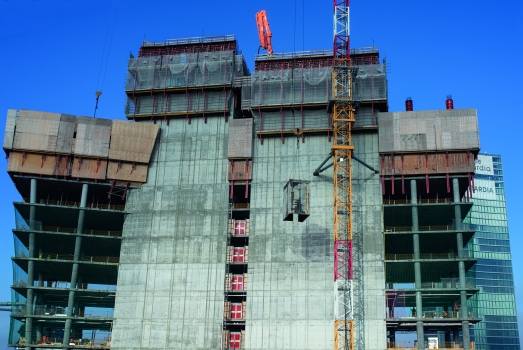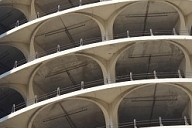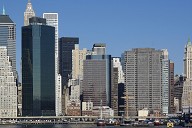Innovative and sustainable: Office complex GIOIA 22 in Milan
GIOIA 22 is setting new benchmarks in terms of sustainability: the 120 m tall tower at the heart of the Porta Nuova district will cover 65 percent of its annual energy requirements using renewable energy sources. GIOIA 22 is the first building of its size in Italy to meet the NZEB standard (nearly zero energy consumption building). The 30 storey tall building will provide enough space for approximately 2,700 people, 350 parking spaces and 13 lifts.
Media
A characteristic feature of the building is its folded shape which is of ecological significance in addition to being aesthetically pleasing. State-of-the-art technology and structural planning will allow the exterior and interior spaces to be used in an innovative manner. For example, the 225,000 integrated photovoltaic panels will generate enough electricity to supply the equivalent of approximately 300 households. Only two years after the foundation stone was laid in the summer of 2018, the building is due to open this year.
Exceptional design of GIOIA 22
The building consists of a main core with 26 floors and a secondary core with 13 floors. The special feature: from the second floor upwards, the tower starts to fold in on itself so that the slabs become wider with each passing floor.
A project-specific combination of different systems was required to create the unusual shape of the building. For this reason, the decision was made to combine the slab formwork with an additional system solution to realise the slabs from the second floor upwards. Systematic erection sequences and lightweight system components made it possible to complete an entire floor in a week.
Characteristic feature: 17 columns
Characteristic feature of the building are the 17 round columns of which seven columns are inclined. They were erected using circular column formwork. With their high-quality, architectural concrete surfaces, the columns are also aesthetically pleasing. The diameter of the columns vary between 1.0 m and 0.8 m, becoming smaller with the increasing height of the tower.
The client used approximately 1,000 m² of panel formwork to erect the wall space in both cores. A self-climbing system allowed the lifting of the 32 m long concrete distribution arm from floor to floor.
Connection of both building cores
17 climbing protection panel systems with guided rails were used for the building section with consistent geometry. These systems were affixed to the structure at all times. In this way, the climbing protection panel was anchored to the slab shoe and climbing shoe on the floor slabs which, in turn, were affixed with climbing anchors. 15 non-guided, crane-climbed climbing protection panels were used for the inclined section of the tower. In addition, a diagonally-climbed protection wall unit was used and moved without a crane using a mobile climbing hydraulics system.
The process of connecting the main core of the building to the secondary core was one of the key technical challenges of the project. To achieve this, the first climbing unit was installed using vertical as well as laterally inclined climbing rails. The cantilevered section of the roof slab on the 25th floor, which, at 10 m, is twice as high as the other floors, was implemented with the aid of shoring towers. They were supported by climbing rails and steel walers that were anchored to the slab.
Sophisticated safety concept
Safety at the jobsite was of paramount importance despite the need to achieve quick results: the climbing protection panels were used for gap-free enclosure of the floors in the building shell. On the one hand, they served as guardrails, but also provided additional protection from the wind and prevented objects from falling off the building. In addition, over 4,000 linear metres of “PROKIT” were used as guardrails on building edges. This meant that the construction site team could work safely and efficiently at all times.
Efficient transportation of materials
Two material platforms were used to move essential materials from one floor to another. The platforms were the ideal means of transportation on the jobsite due to their high load capacity and flexible mounting options. They made it possible to move packages with dimensions of up to 5.30 m x 2.30 m and weights of up to 3000 kg.
References
Structure Types
- About this
data sheet - Product-ID
7678 - Published on:
31/07/2020 - Last updated on:
31/07/2020

